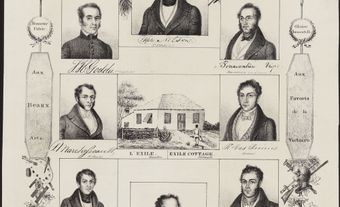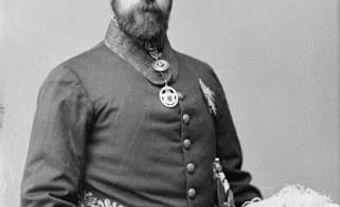This article was originally published in Maclean’s magazine on May 18, 1998. Partner content is not updated.
No, Levi-Strauss is not in talks to merge with Italy's Armani. Nor, as far as anyone knows, is McDonald's planning to team up with a chain of snooty French restaurants.Mercedes-Chrysler Merge
No, Levi-Strauss is not in talks to merge with Italy's Armani. Nor, as far as anyone knows, is McDonald's planning to team up with a chain of snooty French restaurants. But in the category of seemingly improbable corporate pairings, few other deals can compare with last week's odd-couple marriage of Detroit-based Chrysler Corp. and Germany's Daimler-Benz AG, maker of Mercedes-Benz cars. The former is a mass-market American automaker known for its snazzy vehicle lineup and sometimes less-than-stellar quality. The latter, a polished if plodding symbol of German engineering excellence, churns out solid and conservatively styled luxury cars for wealthy buyers the world over. Talk about a culture clash.
Yet when North America's third-largest carmaker announced a $57-billion merger with Germany's biggest industrial firm, almost no one in the global auto sector questioned the logic of the deal. Union leaders, rival manufacturers and financial analysts all said the partnership makes perfect sense, giving Chrysler the international presence it has always lacked and establishing Daimler-Benz as a major player in North America, where it is weak. What remains unclear is whether the deal - the world's biggest merger between manufacturing companies - will trigger a wave of similar alliances in the auto industry, which is struggling with chronic overcapacity, skyrocketing research-and-development costs and cutthroat international competition.
The answer to that will depend in part on how successful Daimler-Benz and Chrysler are in uniting their operations under one banner. DaimlerChrysler, as the new entity will be called, will have 420,000 employees and 24 car and light-truck assembly plants in six countries. With $189 billion in annual revenues, it will rank as the world's third-largest auto company, behind General Motors and Ford but well ahead of Toyota.
The numbers are formidable but so are the challenges - not only in reconciling two dramatically different corporate cultures, but in making sure that the whole is greater than the sum of the parts. The effective takeover of Chrysler by a German-controlled company - under the deal, Daimler-Benz shareholders will own 57 per cent of the new company - also calls into question the future of the Canada-U.S. Auto Pact. Under that 33-year-old treaty, North American automakers can import vehicles and parts duty-free from anywhere in the world, while foreign manufacturers, including Daimler-Benz, are required to pay a 6.7-per-cent tariff.
Despite such obstacles, the two men who engineered last week's deal sounded unreservedly optimistic about the new company's prospects. "We are leading a new trend we believe will change the future, the face of the industry," Chrysler chairman Bob Eaton, 58, said at a joint news conference in London. Daimler-Benz chairman Juergen Schrempp, 53, added that the two companies do not anticipate any plant closures or layoffs. "On the contrary," he said, "we estimate with the combined strength we will grow, we will add volume and we will be creating jobs on both sides of the Atlantic."
Already, Eaton and Schrempp have resolved one of the thorniest issues confronting companies that try to merge: the problem of executive control. During the first three years, they will share the posts of chairman and CEO. After that, Eaton plans to step down and leave his German counterpart alone at the top.
Given their personality differences, that is probably just as well. A mechanical engineer who ran General Motors' European operations before joining Chrysler as chief operating officer in 1992, Eaton is a low-key team builder who shuns the spotlight and happily gives credit to others for his company's recent successes. Schrempp, in contrast, is a blunt and outspoken autocrat who secured his own power base three years ago by insisting that the Daimler-Benz board of directors get rid of a popular fellow executive. His predecessor as CEO, Edzard Reuter, says the cigar-chomping Schrempp shows "ruthless brutality" in business dealings. At work and at play, Schrempp is known for making waves. In 1995, he and two colleagues were briefly detained by police in Rome after they were found whooping it up with a bottle of wine at one of the city's most popular tourist attractions, the Spanish Steps.
The irony is that, for years, Chrysler has been the most strongly nationalistic of Detroit's Big Three automakers. After a brush with bankruptcy in 1980 - during which it was rescued with U.S. and Canadian government loan guarantees - the company fought back with a lineup of new cars and minivans and repeated appeals to consumers to "buy American." More recently, its Canadian subsidiary has been at the forefront of a campaign to preserve Canada's 6.7-per-cent duty on imported cars, including Mercedes-Benz.
That Chrysler has now decided to gamble its future on German ownership is a measure of how much the auto industry has changed during the past two decades - and is likely to continue changing. During the late 1980s, a wave of consolidation saw Chrysler take over American Motors, including its Jeep division, while Ford acquired Britain's Jaguar and a minority interest in Mazda of Japan. Meanwhile, GM took control of the Swedish automaker Saab and bought a chunk of Japan's Isuzu. Later, BMW took over Britain's Rover Group, and Sweden's Volvo came close to joining forces with Renault.
Coincidentally, on the same day that Chrysler and Daimler-Benz announced their merger, Britain's Vickers PLC agreed to sell Rolls-Royce Motor Cars to Volkswagen for $994 million. In doing so, Vickers walked away from an earlier $813-million agreement with BMW. Vickers shareholders will be asked to choose between the two bids at a special meeting on June 4.
All of these deals have one thing in common: a desire to wring further efficiencies out of an industry that faces intense competition, declining profit margins and stagnant markets in industrialized countries. Of the world's major automakers, Chrysler has been among the most successful in adapting to the harsh new realities of the auto business. Its near-death experience in 1980, coupled with a similar financial crisis at the beginning of the 1990s, forced the company to streamline operations from top to bottom, eliminating layers of management and implementing Japanese-style product-development teams. Those changes have made Chrysler one of the industry's most innovative and nimble manufacturers, capable of designing and introducing a new vehicle from scratch in less than 36 months - roughly a year faster than its North American rivals. Thanks to the popularity of its minivans and four-wheel-drive sport utility vehicles, it is also the world leader in per-vehicle profitability.
Despite those achievements, Chrysler's heavy dependence on North American sales has left it more vulnerable than either Ford or GM - both of which have extensive European operations - to cyclical downturns in the American and Canadian economies. For that reason, analysts praised the decision to join forces with Daimler-Benz, which, in addition to being a European powerhouse and luxury car specialist, is the world's biggest manufacturer of heavy trucks and a leading producer of commercial vans and buses.
For Daimler-Benz, the merger offers other potential advantages. Schrempp and his associates make no secret of their admiration for Chrysler's renowned speed and efficiency, qualities they hope will rub off on the slower, more risk-averse German company. In addition, Daimler-Benz has wanted for years to expand out of its luxury niche into the high-volume business of building popularly priced vehicles. Adding Chrysler to its family of products instantly gives Daimler-Benz an established brand at the lower end of the market, without diluting the more refined Mercedes-Benz image.
Mercedes also will likely try to leverage Chrysler's expertise in light trucks, which now account for two-thirds of the U.S. company's North American sales. Mercedes' first entry in that field, the ML320 sport-utility vehicle, which went into production last fall at a new plant in western Alabama, is already a runaway success. In future, the company could spin off new minivans and sport utility vehicles based on existing Chrysler platforms, thereby saving hundreds of millions of dollars in development costs.
The benefits for consumers, if any, are more difficult to calculate. In theory, a more efficient manufacturer should mean lower prices for car buyers, but the scale of last week's merger is such that it may take years before most of those savings are realized. In any case, the prices charged by automakers for their products are generally a function of the overall competitive environment and consumer demand rather than any one company's internal cost structure. That is why Chrysler, for example, now earns as much as $10,000 in profit on each of its popular high-end SUVs, while barely breaking even on economy and mid-priced family cars.
Consumers and autoworkers most certainly will feel the effects if the DaimlerChrysler deal sets the stage for a new round of alliances and cost-cutting among major car companies. Eaton is among those who believes it will. "We are convinced, and we have been convinced for a long time, that there really will be a consolidation, and ultimately in 10 to 20 years we'll be down to eight, nine or 10 manufacturers, versus the 18 or 19 that's out there now," he told an interviewer last week.
Investors seem to agree. In heavy trading last week, they bid up the shares of several major European automakers - Peugeot Citroën, Renault, Fiat and Volvo - on the assumption that each of those firms is a prospective takeover target for a larger, more powerful company. Some analysts believe BMW itself could soon become a target for cash-rich Ford or General Motors. In Japan, there is talk of a full-scale acquisition of Mazda by Ford, and further consolidation among smaller players such as Mitsubishi Motors Corp. and Subaru. Nissan, which has struggled in recent years and is losing market share in North America to both Toyota and Honda, is also a possible merger candidate.
If those predictions prove correct, the impact could easily outstrip that of the DaimlerChrysler merger. In the current deal, there is remarkably little overlap between the two partners, which means the two organizations can be melded without any obvious duplication in product lines. Future auto mergers, however, might not be nearly so neat and tidy. Nissan's lineup, for example, runs all the way from budget-priced runabouts to $70,000 luxury cars, as well as pickups, the four-wheel-drive Pathfinder and a U.S.-built minivan. Any attempt to combine that company with another major automaker, in Japan or elsewhere, would likely force the elimination of several competing car and truck lines and the loss of tens of thousands of jobs.
Now that Eaton and Schrempp have shown the way, however, the drive to consolidate may be unstoppable. Consider what has happened in the North American banking sector in only the past six months: once several of the big players announced their intention to merge, the pressure was on rival banks to do the same, or else come up with a convincing explanation for their decision to remain on the sidelines. Suddenly, going it alone began to sound like the riskier of two options.
In an era of global brands and converging consumer tastes, the auto industry may have no other choice but to follow the example of Daimler-Benz. "This industry is consolidating," Eaton said. "We believe this is just the beginning." Gentlemen, start your engines.
BIG WHEELS
Base prices in Canadian dollars:
Plymouth Neon: $15,975
Chrysler Intrepid: $24,395
Dodge Grand Caravan: $24,690
Jeep Grand Cherokee: $36,030
Mercedes-Benz CLK320: $56,950
Mercedes-Benz SL600: $159,750
WORLDS APART
Revenue by region, in billions:
Chrysler:
United States: $74.9
Canada: $7.1
Other: $6
Daimler-Benz:
Europe: $63.2
United States: $20.9
Other: $15.7
Canada: $0.5
Maclean's May 18, 1998

 Share on Facebook
Share on Facebook Share on X
Share on X Share by Email
Share by Email Share on Google Classroom
Share on Google Classroom


